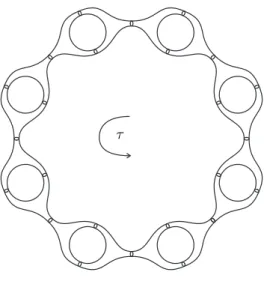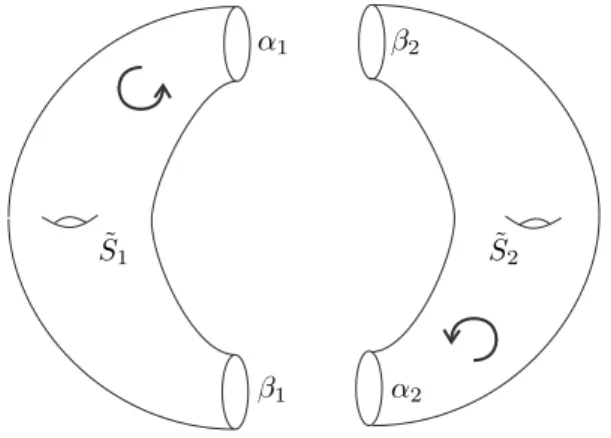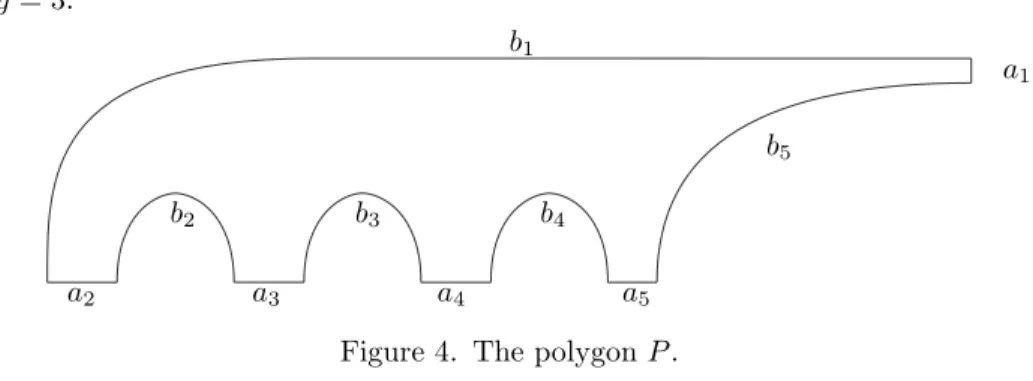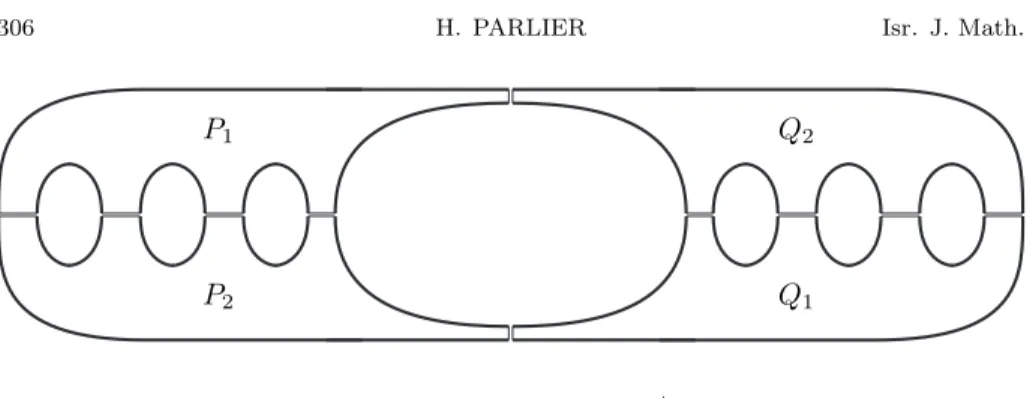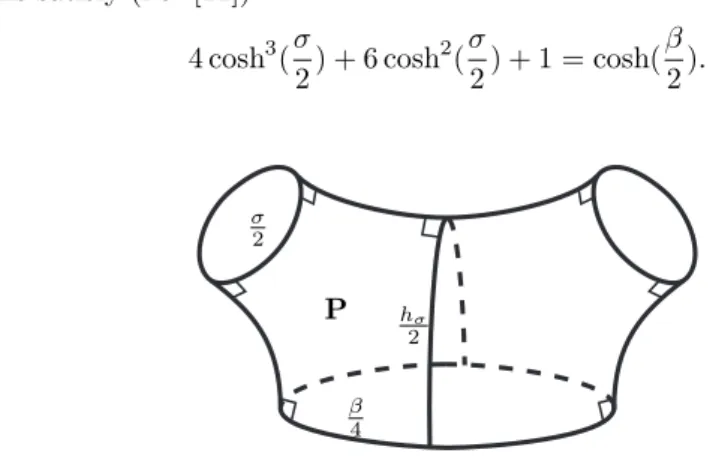FIXED POINT FREE INVOLUTIONS ON RIEMANN
SURFACES
BY
Hugo Parlier∗
SIGAT Institute, EPFL, Bˆatiment BCH CH-1015 Lausanne Switzerland
e-mail: hugo.parlier@epfl.ch
ABSTRACT
In this paper, involutions without fixed points on hyperbolic closed Rie-mann surface are discussed. For an orientable surface X of even genus with an arbitrary Riemannian metric d admitting an involution τ , it is known that minp∈Xd(p, τ (p)) is bounded by a constant which depends on the
area of X. The corresponding claim is proved to be false in odd genus, and the optimal constant for hyperbolic Riemann surfaces is calculated in genus 2.
1. Introduction
Involutions play an important role in the study of compact Riemann surfaces. For instance, the study of hyperelliptic surfaces of genus g is the study of surfaces admitting an orientation preserving involution with 2g + 2 fixed points and the study of non-orientable surfaces is essentially the study of the quotient of certain Riemann surfaces by orientation reversing involutions. Furthermore, by the uniformization theorem, surfaces with an orientation reversing involution are conformally equivalent to real algebraic curves. A further motivation can be found in [1] where the so-called filling area conjecture is treated. The conjecture, originally made in [5] for the n-dimensional case, states (in two dimensions) that
∗The author was supported in part by the Swiss National Science Foundation grants
20 - 68181.02 and PBEL2-106180.
Received October 19, 2005 and in revised form January 26, 2007
any surface S with a simple boundary component, endowed with a Riemannian metric with the property that diametrically opposite points on the boundary are of distance grater than or equal to π on the surface, has area greater than or equal to 2π, equality occurring only in the case of the classical hemisphere. The conjecture is equivalent to the following
Conjecture: Let S be an orientable surface of even genus with a Riemannian metric d that admits an orientation reversing involution τ . Then there is a point p∈ S with (1) d(p, τ (p)) 2 area(S) ≤ π 4.
In [1], this problem is solved when S is hyperelliptic, thus particularly for genus 2. Furthermore, in the general case, in [6] it is shown that a p ∈ S can be chosen such that
(2) d(p, τ (p))
2
area(S) ≤ 1
If S is a hyperbolic Riemann surface of even genus g, this shows that there is a p∈ S such that
(3) d(p, τ (p))≤p2π(2g − 2).
The idea of the paper is to treat these questions in more detail for hyperbolic Riemann surfaces. The first main result of the article is to show that the conjecture stated above cannot be extended to odd genus, even if one restricts oneself to hyperelliptic surfaces.
Theorem 1.1: For any odd g ≥ 3 and positive constant k, there exists a hyperbolic Riemann surface S of genus g admitting an orientation reversing involution τ which satisfies d(p, τ (p)) > k for all p∈ S. Furthermore, S can be chosen hyperelliptic.
The corresponding problem for orientation preserving involutions is also treated, with the same result.
Although the bound of inequality (1) is optimal for hyperelliptic metrics, it does not give a sharp bound for hyperbolic metrics in genus 2. This sharp bound is the object of the second main result of the article.
Theorem 1.2: Let S be a Riemann surface of genus 2 endowed with a hyper-bolic metric and an involution τ . On S, there is a p such that d(p, τ (p)) ≤ arccosh5+√17
2 . This upper-bound is sharp and is attained by a unique
hyper-bolic Riemann surface of genus 2 (up to isometry).
Compare this optimal bound (= 2.19 . . . ) with the bound from inequality (3) (= 2√π). The unique surface which attains this upper bound is not the hyper-bolic surface found in the conformal class of the Bolza curve. This is somewhat surprising because the hyperbolic representative of the Bolza curve is maximal for systole length, number of systoles (12), and number of automorphisms (48) (see [11]). Also, it has been shown in [7] that the surface that satisfies the case of equality of the optimal systolic inequality for hyperelliptic invariant CAT(0) metrics in genus 2 is in the conformal class of the Bolza curve.
This paper is organized as follows. The purpose of Section 2 is to give basic definitions, notations and well-known facts concerning the relationship between involutions, simple closed geodesics and hyperbolic metrics. Section 3 contains the proof of Theorem 1.1 and Section 4 treats the proof of Theorem 1.2. Remark: After the first version of this paper was made public, M. Gendulphe [4] found closely related results to Theorem 1.2.
2. Definitions, notations and preliminaries
The article primarily concerns compact surfaces endowed with a hyperbolic metric. The following notation and definitions refer to such surfaces. We shall suppose that the boundary of a surface is a collection of simple closed geodesics. The signature of the surface denoted (g, n) (genus and number of boundary components), verifies (g, n)≥ (0, 3) (with lexicographic ordering) and (g, n) 6= (1, 0). This condition is imposed by the existence of a hyperbolic metric. A surface of signature (0, 3) is commonly called a pair of pants. The area of a hyperbolic surface is given by area(S) =−2πχ(S) where χ(S) = 2 − 2g − n is the Euler characteristic of the surface. Unless specifically stated, a geodesic is a simple closed geodesic on S. Distance on S (between subsets, points or curves) is denoted d(·, ·).
Curves and geodesics will be considered primitive and non-oriented, and can thus be seen as point sets on S. A geodesic γ (resp. a set of geodesics E) is called separating if S\ γ (resp. S \ E) is not connected. Let us recall that a
non-trivial closed curve c (not necessarily simple) on S is freely homotopic to exactly one closed geodesic γ. The unique geodesic in the free homotopy class of c will be denoted
(4) G(c) = γ.
If c is simple, then so is γ. We shall denote by int(γ, δ) the number of transversal intersection points between two geodesics γ and δ. The length of a path or a curve will be denoted `(·), although a curve’s name and its length may not be distinguished.
We shall readily use the following well-known result, commonly called the collar theorem (i.e. [2], [3], [8], [10]).
Theorem 2.1: Let γ1and γ2be non-intersecting simple closed geodesics on S. Then the collars
C(γi) ={p ∈ S : dS(p, γi)≤ w(γi)}
of widths
w(γi) = arcsinh(1/ sinh(γi/2))
are pairwise disjoint for i = 1, 2. Furthermore, each C(γi) is isometric to the
cylinder [−w(γi), w(γi)]× S1 with the metric ds2= dρ2+ γi2cosh 2
ρ dt2.
Notice that the γi’s divide their collar into two connected spaces which we
will call half-collars. In the sequel we will make use of the fact that the collars of two disjoint geodesics are also disjoint.
The systole σ of a surface is defined as the (or a) shortest non-trivial closed curve on S. (One could argue that it may be more appropriate to denote this curve a systolic loop and its length the systole, but here we’ve chosen the most common denomination in the hyperbolic surface setting.) A systole is always a simple closed geodesic and cannot intersect another systole more than once.
An involution τ is an isometric automorphism of the surface that is of or-der 2. Involutions can either be orientation preserving or reversing. For Rie-mann surfaces this is equivalent to: whether the involution is holomorphic or antiholomorphic. Simple closed geodesics and orientation reversing involutions are closely related. The following proposition is an extension of what is generally called Harnack’s theorem and can be found in [9].
Proposition 2.2: If a surface S admits τ , an orientation reversing involution, then the fixed point set of τ is a set of n disjoint simple closed geodesics B = {β1, . . . , βn} with n ≤ g + 1. In the case where the set B is separating, S \ B
consists of two connected components S1 and S2such that ∂S1= ∂S2=B and
S2= τ (S1). If not, thenB can be completed by a set α which consists of one or
two simple closed geodesics such thatB ∪ α has the properties described above (with the important difference that α does not contain any fixed points of τ ). Each of the simple closed geodesics in α is globally fixed by τ .
3. Involutions and surfaces of odd genus
The main goal of this section is to give a proof of Theorem 1.1. Let S be a surface of genus g ≥ 2, endowed with a hyperbolic metric and a fixed point free involution τ .
Proposition 3.1: If g is even, then τ is orientation reversing.
Proof. Suppose τ is an orientation preserving involution without fixed points of a surface S of genus g. Then S/τ = ˜S is a closed surface of Euler characteristic 1− g (because the Euler characteristic is multiplicative under unramified cov-erings). It follows that the genus ˜g of ˜S is equal to (g + 1)/2 which is possible only if g is odd.
The following propositions concern further relationships between simple closed geodesics and involutions. Suppose that S is a hyperbolic surface of genus g ≥ 2 and τ is a fixed point free involution.
Proposition 3.2: Let σ be a systole of S. Then σ∩ τ(σ) = ∅ or σ = τ(σ). Proof. Suppose that σ6= τ(σ). As τ(σ) is necessarily another systole of S, then the curves σ and τ (σ) cannot intersect more than once (this would imply the existence of a shorter non-trivial closed curve on S). Suppose that σ∩τ(σ) = p, where p is a point. Then τ (p) = p which contradicts the hypotheses.
As S is compact, the value minp∈Sd(p, τ (p)) exists and is attained for at least one point.
Proposition 3.3: Let p∈ S such that d(p, τ(p)) is minimum. Then p lies on a simple closed geodesic γ of length 2d(p, τ (p)) that verifies γ = τ (γ).
Proof. Let p be such a point. Let cp be a minimal path between p and τ (p)
(thus d(p, τ (p)) = `(cp)). Notice that cp∩ τ(cp) ={p, τ(p)}, and the two paths
cp and τ (cp) are not freely homotopic among simple paths with endpoints on p
and τ (p). (Given two points on a hyperbolic surface and a homotopy class of simple curves between them, there is a unique geodesic between the two points in the homotopy class.) Thus cp∪ τ(cp) is a non-trivial simple closed curve.
Furthermore, it follows that γ = τ (G(cp∪ τ(cp)) =G(cp∪ τ(cp)) and thus for
q ∈ γ, d(q, τ(q)) ≤ d(p, τ(p)) with equality occurring only in the case where G(cp∪ τ(cp)) = cp∪ τ(cp). This implies that p lies on γ and that γ is of length
2d(p, τ (p)).
Notice that for such a geodesic γ, all points are diametrically opposite to their images by τ . This is in fact true for any simple geodesic left invariant by τ . Proposition 3.4: Let γ be a simple closed geodesic such that τ (γ) = γ. Then the image τ (p) of p∈ γ is the point on γ diametrically opposite from p. Proof. In particular, τ is an involution acting on γ, and the only fixed point free isometric involution acting of a circle is the rotation of angle π.
As mentioned in the introduction, a result in [6] implies that for any S of even genus with an involution τ (necessarily orientation reversing by proposition 3.1), then there is a point p∈ S such that
d(p, τ (p))≤parea(S).
This is false in odd genus for both orientation preserving and reversing in-volutions. To give an idea of why this is not the case for odd genus, we shall consider the following subsurface of R3.
Let us suppose that the surface is as symmetric as it looks. In particular, it admits an obvious orientation preserving isometric involution τ given by the rotation of angle π of the surface. Now for any fixed area, the surface can be chosen “thin” enough (i.e., the simple closed curves on depicted on the figure are short) so that points are sent arbitrarily far away by τ . Notice that the odd genus is essential in this construction. To obtain orientation reversing involutions with the same property, one could compose τ with the reflection along a plane perpendicular to the axis of τ such that the surface remains invariant (roughly speaking the plane containing the figure).
τ
Figure 1. An example in R3.
Theorem 3.5: Let g ≥ 3 be an odd integer and k a positive constant. There exists a hyperbolic Riemann surface S of genus g admitting an orientation preserving involution τ which verifies d(p, τ (p)) > k for all p ∈ S. The same result holds for orientation reversing involutions. Furthermore, in both cases, S can be chosen hyperelliptic.
Proof. We shall begin by showing the general idea for constructing surfaces with orientation preserving involutions, then surfaces with orientation reversing involutions which satisfy the conditions of the theorem. Finally, we shall give an explicit example of a hyperelliptic surface which has both an orientation preserving involution, and an orientation reversing involution which verifies the conditions of the theorem.
Consider a surface ˜S of signature (˜g, 2) with boundary geodesics α and β of equal length x. Let pαand qα be two diametrically opposite points on α, and
pβ and qβ be two diametrically opposite points on β. Consider two identical
copies of ˜S, say ˜S1 and ˜S2. For k ∈ {1, 2}, denote the copies of α, β, pα, qα,
pβ and qβ on ˜Sk by αk, βk, pαk, qαk, pβk and qβk. Paste ˜S1 and ˜S2 along
their boundary geodesics such that α1 is pasted to β2, and α2 is pasted to β1.
Further, ensure that the pasting is such that the points labeled p are pasted together (for instance pα1is pasted to pβ2).
The resulting surface S is an orientable surface of genus 2g + 1 admitting an orientation preserving involution τo without fixed points which acts as follows:
a point originally on ˜S1is sent to its corresponding point on ˜S2and vice-versa.
The simple closed geodesics of S, previously the boundary geodesics of ˜S1 and
˜
S2, are of length x and are reversed by τo.
α1 α2 β1 β2 ˜ S1 S˜2
Figure 2. Example in genus 3 with orientation preserving involution. The image τo(p) of a point p∈ S is at least “half a collar away” from p, and
by the collar theorem the following inequality is thus satified: d(p, τo(p)) > arcsinh(1/ cosh(x/2)).
The half-collar length tends to infinity as x tends to 0, thus for any k > 0, it suffices to chose x such that k < arcsinh(1/ cosh(x/2), and the result follows.
Now let us treat the case of orientation reversing involutions. Consider a ˜S as above. Instead of pasting two identical copies of ˜S, consider ˜S and a symmetric copy of ˜S (a mirror image), say ˜S−. Denote by α− and β− the images of α and β on ˜S− as in the following figure.
Paste the boundary geodesics together (α to α−, β to β−) while, as before,
respecting the choice of ps and qs. The resulting surface S is of genus 2g + 1 and the orientation reversing involution τr is the isometry taking a point of ˜S
to its corresponding point on ˜S− and vice-versa. As in the first examples, for
any k, x, the length of both α and β, can be chosen such that d(p, τr(p)) > k
α β− β α− ˜ S S˜−
Figure 3. Example in genus 3 with orientation reversing involution. We shall now give an explicit example of a hyperelliptic surface with both an orientation preserving involution and an orientation reversing involution which verifies the conditions of the theorem.
Consider a right-angled 2g + 4-gon in the hyperbolic plane, say P , with edges labeled in cyclic ordering{a1, b1, . . . , ag+2, bg+2}. The figures are all done when
g = 3. a1 b1 a2 b2 a3 b3 a4 b4 a5 b5
Figure 4. The polygon P .
Take two isometric copies of P , say P1and Q1, and two symmetric images of
P , say P2 and Q2and paste them along the sides labeled ai as in the following
figure to obtain a surface S+of signature (0, 2g + 2). The bold curves represent
the boundary geodesics of S+.
By taking a symmetric copy S− of the surface thus obtained, and denote by
P−
1 etc. the various images of the polygons of S +
. By pasting the two surfaces S+
P1
P2 Q1
Q2
Figure 5. The surface S+.
obtains a surface S of genus 2g + 1. We require the pasting to be exact — each edge of a polygon is pasted exactly to its corresponding edge with end points of each edge coinciding.
P1 P2 Q1 Q2 P− 1 P− 2 Q− 1 Q− 2
Figure 6. The surface S.
The surface thus obtained necessarily admits a number of involutions. One of these is the hyperelliptic involution τh, with fixed points the end points of
all the images of a3, . . . , ag+1. (To be precise, τh exchanges P1and P2−, P2 and
P−
1 , Q1 and Q−2, Q2 and Q−1.)
The remaining involutions we are interested in are the ones without fixed points. The orientation preserving involution τodefined by exchanging P1 with
Q1, P2with Q2, P1−with Q−1, and P2−with Q−1, does not have any fixed points.
The orientation reversing involution τr defined by exchanging P1 with Q−1, P2
with Q−
2, P1− with Q1, and P2− with Q1, does not have any fixed points either.
The eight images of the edge a1 on S form two simple closed geodesics (after
we can chose a sufficiently short a1 such that we have d(p, τo(p)) > k as well as
d(p, τr(p)) > k for all p∈ S.
4. The case of genus 2
For all hyperbolic surfaces of genus 2, inequality 3 of the introduction implies that the minimum distance between a point and the image by an involution is bounded. The object of this section is a detailed study of fixed point free involutions on surfaces of genus 2 leading to the sharp bound on this distance. Lemma 4.1: Let τ be an involution without fixed points on a surface of genus 2. Then the following statements are true:
(1) τ reverses orientation.
(2) S contains a separating simple closed geodesic β such that β = τ (β). The two parts of S separated by β are interchanged by τ .
(3) For any p∈ β, p and τ(p) are diametrically opposite.
Proof. Parts (1) and (3) have been treated earlier in the general case and part (2) is a direct consequence of proposition 2.2 (Harnack’s theorem).
The geodesic β from the previous lemma divides S into two surfaces of sig-nature (1, 1). The following lemma recalls some essential facts about these surfaces. These facts are either well-known, or their proofs can be found in [11, Theorem 4.2]. For such surfaces, and a choice of interior simple closed geodesic α, we denote hα the unique simple geodesic path which goes from boundary to
boundary and intersects boundary at two right angles and does not cross α. We will refer to the geodesic path hα as the height associated to α (see figure 7).
α
hα
Lemma 4.2: Let Q be a surface of signature (1, 1) with boundary geodesic β. Then the following statements are true.
(1) Q is hyperelliptic and its hyperelliptic involution has three fixed points in the interior of Q (the Weierstrass points of Q).
(2) Let γ be an interior simple closed geodesic of Q and denote its as-sociated height hγ. Then γ passes through exactly two of the three
Weierstrass points and the remaining Weierstrass point is the midpoint of hγ. Furthermore, the length of γ is directly proportional to the length
of hγ.
(3) Among all surfaces of boundary length `(β), the unique surface (up to isometry) with maximum length systole is the surface with three distinct systoles.
(4) If Q has three systoles, then their associated heights do not intersect and are evenly spaced along β.
We shall now proceed to the main result of this section.
Theorem 4.3: Let S be a Riemann surface of genus 2 endowed with a hyper-bolic metric and a fixed point free involution τ . On S, there exists p such that d(p, τ (p)) ≤ arccosh(5+√17
2 ). This upper-bound is sharp and is attained by a
unique hyperbolic Riemann surface of genus 2 (up to isometry).
Proof. For S of genus 2, let β be the separating geodesic described in Lemma 4.1. Let Q be one of the two surfaces of signature (1, 1) separated by β. Propo-sition 3.3 implies that a p which minimizes d(p, τ (p) is found on a simple closed geodesic left invariant by τ . As all simple closed geodesics in the interior of both Q and τ (Q) are distinct from their images, p must be found on a simple geodesic that either crosses β or is β.
Let h be a height on Q. Then h∪ τ(h) = γh is a simple closed geodesic
with the property that for p ∈ γh, τ (p) is diametrically opposite to p (lemma
4.1). Furthermore, if σ is a systole on Q, then hσ is the shortest height on Q.
Notice that all simple closed geodesics that cross β are longer that 2hσ, thus
d(p, τ (p)) ≥ hσ, equality occurring when 2hσ ≤ β. For any β, the maximum
value that hσis acheived in the situation described in lemma 4.2. Furthermore,
the maximum value of hσ is strictly proportional to the length of β. The
maximum value for d(p, τ (p)) is thus obtained when both β/2 and maximum hσare equal. These conditions define a unique surface of signature (1, 1), whose
lengths satisfy (i.e. [11]) (5) 4 cosh3 (σ 2) + 6 cosh 2 (σ 2) + 1 = cosh( β 2). σ 2 hσ 2 P β 4
Figure 8. Maximal Q cut along a systole
The figure shows this surface after cutting along a systole σ. The hyper-bolic right angled pentagon P has equal length adjacent edges of lengths hσ/2,
and β/4, and opposite edge of length σ/2. Using the hyperbolic trigonometry formula for such pentagons, one obtains
sinh2
(β/4) = cosh(σ/2) and thus
(6) cosh(β/2)− 1 = 2 cosh(σ/2).
Using equations 5 and 6, the value for a systole σ verifies (7) 2 cosh2(σ/2)− 3 cosh(σ/2) − 1 = 0.
From this we can deduce the value hσ=
β
2 = arccosh(
5 +√17 2 ).
In order to obtain the maximal surface of genus 2, it suffices to take two copies of the maximum surface of signature (1, 1) and to paste them such that minimum length heights touch. As the heights are evenly spaced along β, whichever way this is done one will obtain the same surface. This surface, say Smax, is clearly unique up to isometry. The following figure explicitly illustrates
how to obtain Smax by pasting 8 copies of P. On P, consider the midpoint
the 8 copies of this point and the points p3and q3are as labeled on the figure.
The pasting of the boundary geodesics is as indicated in the figure (p1 pasted
to p1etc.). The Weierstrass points of Smaxare exactly the points p1, p2, p3 and
q1, q2, q3. p1 p2 p2 p1 q1 q2 q2 q1 p3 q3 Figure 9. Smax
Notice that there are exactly 6 systoles on this surface, and the length of a systole of the surface is the same as a systole on the maximal (1, 1) surface. The length of a systole, by equation 7 is
σ = 2 arccosh(3 + √
17 4 ).
The maximal surface Smaxwe have constructed above has a remarkable
prop-erty: it is not the Bolza curve. The Bolza curve, with its unique hyperbolic metric, is constructed in the same fashion, namely, it is obtained by pasting two maximal surfaces of signature (1, 1). It is the unique maximal genus 2 sur-face for systole length. Compared to Smax, its separating geodesic β is longer
Acknowledgements
I would like to thank the referee for valuable remarks and corrections. Many thanks to Mikhail Katz for his suggestions and for carefully reading a prelim-inary version of this paper. Finally, I would like to thank a variety of people I have shared my ideas with, and, in particular, Florent Balacheff and Peter Buser.
References
[1] V. Bangert, C. Croke, S. Ivanov, and M. Katz, Filling area conjecture and ovalless real hyperelliptic surfaces, Geometric and Functional Analysis 15 (2005), 577–597.
[2] P. Buser, The collar theorem and examples, Manuscripta Mathematica 25 (1978), 349–357.
[3] P. Buser, Geometry and spectra of compact Riemann surfaces, of Progress in Mathemat-ics, vol. 106, Birkh¨auser Boston Inc., Boston, MA, 1992.
[4] M. Gendulphe, Paysage systolique des surfaces hyperboliques compactes de caracteris-tique -1, available on the arxiv:math.DG/0508036, 2005.
[5] M. Gromov, Filling Riemannian manifolds, Journal of Differential Geometry 18 (1983), 1–147.
[6] S. V. Ivanov and M. G. Katz. Generalized degree and optimal Loewner-type inequalities, Israel Journal of Mathematics 141 (2004), 221–233.
[7] M. G. Katz and S. Sabourau. An optimal systolic inequality for CAT(0) metrics in genus two, Pacific Journal of Mathematics 227 (2006), 95–107.
[8] L. Keen, Collars on Riemann surfaces, in Discontinuous groups and Riemann surfaces (Proc. Conf., Univ. Maryland, College Park, Md., 1973), Annals of Mathematics Studies, Princeton University Press, Princeton, N.J., 1974, pp. 263–268.
[9] I. Kra and B. Maskit. Bases for quadratic differentials, Commentarii Mathematici Hel-vetici 57 (1982), 603–626.
[10] B. Randol, Cylinders in Riemann surfaces, Commentarii Mathematici Helvetici 54 (1979), 1–5.
[11] P. Schmutz. Riemann surfaces with shortest geodesic of maximal length, Geometric and Functional Analysis 3 (1993), 564–631.
